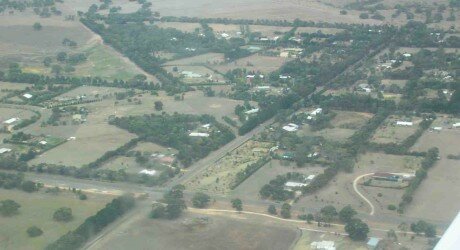Teesdale from the air. The original proposal was for a sand quarry in the brown patch at the top left of the picture. Photo: Roy Hay.
What’s Teesdale worth?
By Roy Hay
As they say, the price of democracy is eternal vigilance, so that is probably what is required of the residents of Teesdale too. Recently an excavation company withdrew an application for a permit for a sand quarry on the edge of the village, following the revelation that it was a prohibited industry in that location. That company has the approval of a local landowner to seek planning permission to quarry in two other paddocks near the village.
The village and its immediate environs are in what is termed a Low Density Residential Zone (LDRZ) but that only extends a couple of hundred metres from the outer edge of the currently settled area. Beyond that lies the Farming Zone (FZ). Extractive industries may obtain planning permits for development in the Farming Zone. So it is open for the developer to apply for the opportunity to quarry there.
Golden Plains Council was no doubt taken aback by the extent of local protest about the original application but it is unclear how it would react to another proposal located slightly further from the village. In January 2008, the Shire adopted a Rural Land Use Strategy report by Parsons Brinckerhoff Australia Pty Ltd which included the following objective: ‘Provide for value adding rural industries, including intensive animal industries, where they can be sited so as to avoid conflicts and impacts on towns and settlements, residential uses, other agriculture uses and identified environmental values.’
That report drew on another study by DPS Dawson Planning Services Ltd and GMR Engineering Pty Ltd in September 2006 which mentioned a buffer area around towns of 3 to 5 kilometres for intensive agriculture, that is primarily piggeries and poultry farms. One might think that a sand quarry or similar extractive industry might be subject to the same buffer. Until it is tested one cannot be sure and the actions of the Council in recent times leave room for concern.
The Council, by its own admission, did not rule the previous application out of court until notices had been sent to neighbouring property holders with only 14 days to respond. So it is quite possible that the people in Teesdale could be put through another period of anxiety and uncertainty unless the Council makes clear what it considers to be a sufficient buffer between residential areas and extractive industries. The guidelines under existing Victorian planning legislation are not prescriptive except as to the various items of legislation and regulation which the Council must take into account before making its decision.
The State Planning Policy Framework and the Local Planning Policy Framework, including the Municipal Strategic Statement and the Golden Plains Planning Scheme form a complex of regulation which would deter most people who seek to understand how the system works. For officials and elected Councillors trying to fathom and exercise their responsibilities they must be a nightmare at times. One of these responsibilities is to encourage development and employment in the Shire, so they should be reluctant to place unnecessary barriers to commercial operations which would benefit the localities. The Council would like to be able to treat any future application on its merits, rather than prejudge the issue. However, it would save a great deal of local angst if they would indicate clearly the extent of the buffer zone which should exist for industrial or extractive operations around small townships and villages to prevent or reduce the likelihood of a repeat of the recent exercise.
While the current uncertainty centres on Teesdale, the principle would be applicable to any other of the small villages which form the main basis of settlement in the rural parts of the shire. That really would change the attractiveness of Golden Plains to the people who are drawn to the area precisely because it is not a dense urban settlement.
Roy Hay lives at the other end of Teesdale








Marnie Haig-Muir: Your review of the latest Rankin is right on the money, Roy. This book...